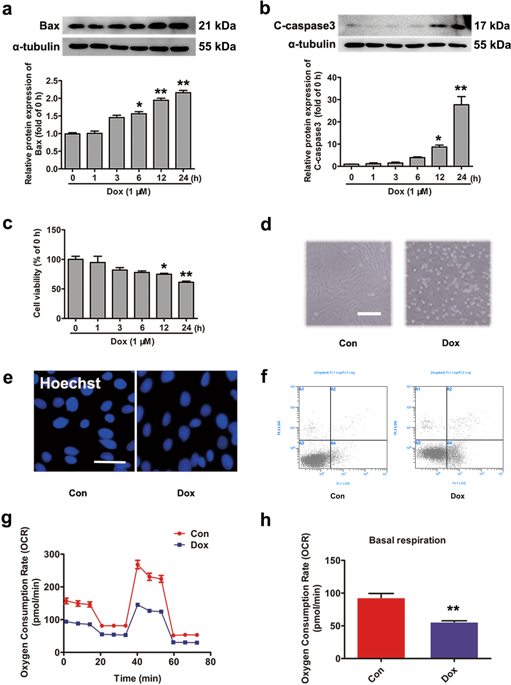当前位置:
X-MOL 学术
›
Acta Pharmacol. Sin.
›
论文详情
Our official English website, www.x-mol.net, welcomes your
feedback! (Note: you will need to create a separate account there.)
sFRP1 protects H9c2 cardiac myoblasts from doxorubicin-induced apoptosis by inhibiting the Wnt/PCP-JNK pathway.
Acta Pharmacologica Sinica ( IF 6.9 ) Pub Date : 2020-04-01 , DOI: 10.1038/s41401-020-0364-z Yue-Huai Hu 1 , Jie Liu 1, 2 , Jing Lu 1 , Pan-Xia Wang 1 , Jian-Xing Chen 1 , Ying Guo 1 , Fang-Hai Han 3 , Jun-Jian Wang 1 , Wei Li 4 , Pei-Qing Liu 1, 5
Acta Pharmacologica Sinica ( IF 6.9 ) Pub Date : 2020-04-01 , DOI: 10.1038/s41401-020-0364-z Yue-Huai Hu 1 , Jie Liu 1, 2 , Jing Lu 1 , Pan-Xia Wang 1 , Jian-Xing Chen 1 , Ying Guo 1 , Fang-Hai Han 3 , Jun-Jian Wang 1 , Wei Li 4 , Pei-Qing Liu 1, 5
Affiliation

|
Doxorubicin (Dox) is an effective chemotherapy drug against a wide range of cancers, including both hematological and solid tumors. However, the serious cardiotoxic effect restricted its clinical application. We previously have illuminated the protective role of canonical Wnt/β-catenin signaling in Dox-induced cardiotoxicity. Secreted frizzled-related protein 1 (sFRP1) is one of the endogenous inhibitors of both canonical and noncanonical Wnt signaling. In this study, we investigated the relationship between sFRP1 and noncanonical Wnt/PCP-JNK (Wnt/planar cell polarity-c-Jun N-terminal kinase) pathway in Dox-induced cardiotoxicity in vitro and in vivo. We showed that treatment of H9c2 cardiac myoblasts with Dox (1 μM) time-dependently suppressed cell viability accompanied by significantly decreased sFRP1 protein level and increased Wnt/PCP-JNK signaling. Pretreatment with SP600125, the Wnt/PCP-JNK signaling inhibitor, attenuated Dox-induced apoptosis of H9c2 cells. Overexpression of sFRP1 protected H9c2 cells from Dox-induced apoptosis by inhibiting the Wnt/PCP-JNK pathway. After intraperitoneal injection of a cumulative dose of 15 mg/kg Dox, rats displayed significant cardiac dysfunction; their heart showed inhibited Wnt/β-catenin signaling and activated Wnt/PCP-JNK signaling. These results suggest that sFRP1 may be a novel target for Dox-induced cardiotoxicity.
中文翻译:

sFRP1通过抑制Wnt / PCP-JNK途径保护H9c2心肌成肌细胞免受阿霉素诱导的细胞凋亡。
阿霉素(Dox)是针对多种癌症(包括血液系统肿瘤和实体瘤)的有效化疗药物。但是,严重的心脏毒性作用限制了其临床应用。我们先前已经阐明了经典的Wnt /β-catenin信号传导在Dox诱导的心脏毒性中的保护作用。分泌的卷曲相关蛋白1(sFRP1)是规范和非规范Wnt信号的内源性抑制剂之一。在这项研究中,我们调查了sFRP1与非经典Wnt / PCP-JNK(Wnt /平面细胞极性-c-Jun N末端激酶)途径在Dox诱导的体内和体外心脏毒性之间的关系。我们显示,用Dox(1μM)时间依赖性抑制的细胞活力治疗H9c2心肌成肌细胞,伴随着sFRP1蛋白水平显着降低和Wnt / PCP-JNK信号传导增加。Wnt / PCP-JNK信号抑制剂SP600125预处理可减弱Dox诱导的H9c2细胞凋亡。sFRP1的过表达通过抑制Wnt / PCP-JNK途径保护H9c2细胞免受Dox诱导的凋亡的影响。腹膜内注射15 mg / kg Dox累积剂量后,大鼠表现出明显的心脏功能障碍。他们的心脏显示出抑制的Wnt /β-catenin信号传导和激活的Wnt / PCP-JNK信号传导。这些结果表明,sFRP1可能是Dox诱导的心脏毒性的新目标。sFRP1的过表达通过抑制Wnt / PCP-JNK途径保护H9c2细胞免受Dox诱导的凋亡的影响。腹膜内注射15 mg / kg Dox累积剂量后,大鼠表现出明显的心脏功能障碍。他们的心脏显示出抑制的Wnt /β-catenin信号传导和激活的Wnt / PCP-JNK信号传导。这些结果表明,sFRP1可能是Dox诱导的心脏毒性的新目标。sFRP1的过表达通过抑制Wnt / PCP-JNK途径保护H9c2细胞免受Dox诱导的凋亡的影响。腹膜内注射15 mg / kg Dox的累积剂量后,大鼠表现出明显的心脏功能障碍。他们的心脏显示出抑制的Wnt /β-catenin信号传导和激活的Wnt / PCP-JNK信号传导。这些结果表明,sFRP1可能是Dox诱导的心脏毒性的新目标。
更新日期:2020-04-24
中文翻译:

sFRP1通过抑制Wnt / PCP-JNK途径保护H9c2心肌成肌细胞免受阿霉素诱导的细胞凋亡。
阿霉素(Dox)是针对多种癌症(包括血液系统肿瘤和实体瘤)的有效化疗药物。但是,严重的心脏毒性作用限制了其临床应用。我们先前已经阐明了经典的Wnt /β-catenin信号传导在Dox诱导的心脏毒性中的保护作用。分泌的卷曲相关蛋白1(sFRP1)是规范和非规范Wnt信号的内源性抑制剂之一。在这项研究中,我们调查了sFRP1与非经典Wnt / PCP-JNK(Wnt /平面细胞极性-c-Jun N末端激酶)途径在Dox诱导的体内和体外心脏毒性之间的关系。我们显示,用Dox(1μM)时间依赖性抑制的细胞活力治疗H9c2心肌成肌细胞,伴随着sFRP1蛋白水平显着降低和Wnt / PCP-JNK信号传导增加。Wnt / PCP-JNK信号抑制剂SP600125预处理可减弱Dox诱导的H9c2细胞凋亡。sFRP1的过表达通过抑制Wnt / PCP-JNK途径保护H9c2细胞免受Dox诱导的凋亡的影响。腹膜内注射15 mg / kg Dox累积剂量后,大鼠表现出明显的心脏功能障碍。他们的心脏显示出抑制的Wnt /β-catenin信号传导和激活的Wnt / PCP-JNK信号传导。这些结果表明,sFRP1可能是Dox诱导的心脏毒性的新目标。sFRP1的过表达通过抑制Wnt / PCP-JNK途径保护H9c2细胞免受Dox诱导的凋亡的影响。腹膜内注射15 mg / kg Dox累积剂量后,大鼠表现出明显的心脏功能障碍。他们的心脏显示出抑制的Wnt /β-catenin信号传导和激活的Wnt / PCP-JNK信号传导。这些结果表明,sFRP1可能是Dox诱导的心脏毒性的新目标。sFRP1的过表达通过抑制Wnt / PCP-JNK途径保护H9c2细胞免受Dox诱导的凋亡的影响。腹膜内注射15 mg / kg Dox的累积剂量后,大鼠表现出明显的心脏功能障碍。他们的心脏显示出抑制的Wnt /β-catenin信号传导和激活的Wnt / PCP-JNK信号传导。这些结果表明,sFRP1可能是Dox诱导的心脏毒性的新目标。











































 京公网安备 11010802027423号
京公网安备 11010802027423号